DIAL SINGH, BHAI (1860-1921) was the son of Bhai Deva Singh and Mat Ram Kaur of Ghasitpur village, in Amritsar district. He learnt to read the Guru Granth Sahib in the village gurdwara and enlisted in an infantry battalion at Poona in his early youth. He served for 20 years and had received a gallantry award before he retired on a monthly pension of Rs 4. Dial Singh had married but had no offspring. Shortly before the happenings at Nankana Sahib, he attended a divan (Sikh religious congregation) at Chakk No. 75 Lahuke where he took the initiatory vows of the Khalsa at the hands of Bhai Narain Singh, and offered himself as a volunteer for the jatha or band of Bhai Lachhman Singh ofDharovali. He fell a martyr at Nankana Sahib on 20 February 1921. See NANKANA SAHIB MASSACRE

DIVALI, festival of lights (from Sanskrit dipamala or dipavali meaning row of lamps or nocturnal illumination), is observed all over India on amavasya, the last day of the dark half of the lunar month of Kartika (October-November). Like other seasonal festivals, Divali has been celebrated since time immemorial. In its earliest form, it was regarded as a means to ward off, expel or appease the malignant spirits of darkness and ill luck. The festival is usually linked with the return to Ayodhya of Lord Rama at the end of his fourteen year exile. For the Hindus it is also an occasion for the worship of Laksmi, the goddess of good fortune, beauty and wealth.
DASAUNDHA SINGH, a Dhillon Jatt of Jhabal in Amritsar district, was half brother of the celebrated Baghel Singh, leader of the Karorsinghia misl. He crossed the Beas in 1759, and seized some villages in the Jalandhar Doab. The family retained possession of these under Maharaja Ranjit Singh, supplying in return a contingent of 26 horsemen.
DAKKHANI RAI (d. 1815), a sixth generation descendant of Baba Prithi Chand, the elder brother of Guru Arjan, who had founded an Udasi dera or preaching centre of the Udasi sect at Gharachon, a village in present day Sarigrur district of the Punjab. The rulers of Patiala granted him two villages, Kapial and Batariana, in freehold. Dakkhani Rai was a noncelibate Udasi sadhu, and his descendants are still living at Gharachon. In Bava Brahmanand, Guru L7dasm Matt Darpan, Baba Bishan Sarup and Baba Sarup Das are mentioned as the most respected and most active heads of this branch of Udasis. Baba Sarup Das lived and preached for some time at Shikarpur in Sindh province, and at Amritsar from 1898 till his death there on 22 Assu 1979 Bk / 7 October 1922.
DALLA. BHAI, a devout Sikh of the time of Guru Arjan. Once he, accompanied by Bhai Bhagirath, BhaiJapu and Bhai Nivala, waited upon Guru Arjan and begged to be enlightened whether Guru Nanak worshipped God in the nirguna, the unattributed, or saguna, the attributed form. The Guru, as says Bhai Mani Singh, Sikhan di Bhagat Mala, replied, "Guru Nanak was the worshipper of the Name, nam, which covers both these attributes of God. You, too, should practise nam and seek refuge in the sangat." Bhai Dalla and his companions were gratified to receive the Guru`s precept.
DARGAHA, BHAI, a Bhandari Khatri, figures in Bhai Gurdas`s roster of prominent Sikhs of Guru Hargobind`s time, Varan, XI.28. According to Bhai Mani Singh, Sikhan di Bhagat Mala, Bhai Dargaha once complained to the Guru that some Sikhs when interpreting gurbanife into polemic. Guru Hargobind said that while reasoning with a view to removing doubts and gaining or disseminating true knowledge was beneficial, Sikhs must shun pedantry born of haumai or pride.






